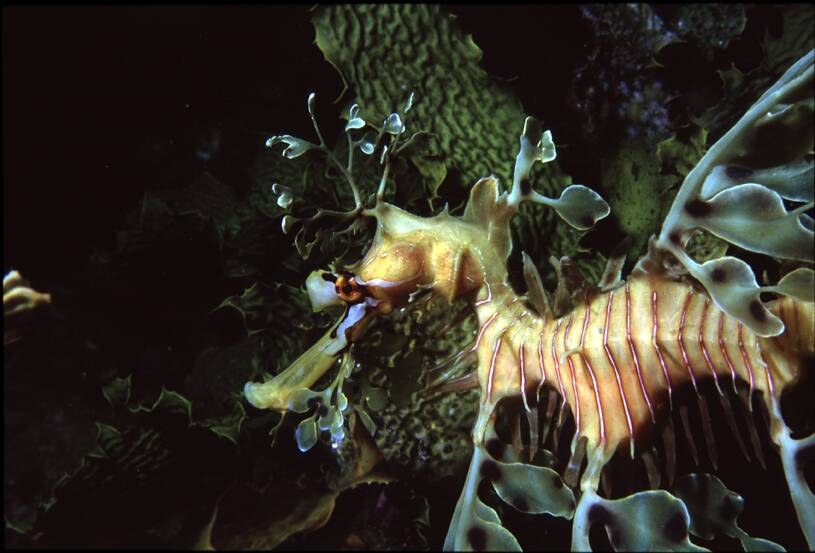
MLSSA Newsletter Sponsor
Jenny Clapson - Kangaroo Island Marine Centre
MLSSA
Newsletter
JUNE 2003
No. 300
"Understanding, enjoying & caring for our oceans"
Next Meeting
This meeting will be held at the Conservation Centre, 120 Wakefield Street, Adelaide on Wednesday 18th June commencing at 7.30pm.
Our speaker will be Dr Sean D. Connell from the University of Adelaide whose topic will be "Research into Southern Australia’s marine life".
This promises to be a very interesting talk and I hope everyone will arrive by 7.30pm so the speaker will be able to begin on time.
Contents
MV Falie Easter 2002 Pt 4
After The Encounter Pt 6
Applying Pain Theory In Fish Spine Envenomation Pt 3
Anniversaries
Anniversary Trophy
The Editor
Contacts Sought
William (Bill) B. Henry
Contributors
This month our authors or contributors are Chris Hall, Steve Reynolds, David Muirhead, Claude Arnal and W. B. (Bill) Henry.
2003 MLSSA Election Results
COMMITTEE
:PRESIDENT : Philip Hall
SECRETARY : Steve Reynolds
TREASURER : Phill McPeake
COMMITTEE : David Muirhead
MEMBERS : Chris Hall
NON-EXECUTIVE:
Editor: Philip Hall
SDF Rep.: Steve Reynolds
Con Council Rep.: Chris Hall
Reefwatch Rep.: Vacant for now
Social Officer: Maggie McGilchrist
Photo Index Officer: Steve Reynolds
Librarian: Steve Reynolds
Auditor: Phill John
Website Manager: Danny Gibbins
Easter 2002
PART 4
By Chris Hall
Day broke to reveal perfect weather conditions. It couldn't get any better than this. No wind or cloud, flat calm sea and an estimated temperature of 25C. Tailor made for diving. A grand day.
While we were breakfasting on another gastronomic delight the crew got us under way for a short trip to the next diving location. After about an hour or so’s sailing we arrived at our destination ‘Pissy Boy Rock’, so named because when the sea swells it causes a spout of water to shoot out just like the famous statue in an European city which name eludes me at the moment.
Secure at anchor, while the crew made ready the dive boats and the first group kitted up, the rest of us were entertained by a group of New Zealand fur seals frolicking in the sea about 200 metres away. It was very pleasant just milling around the deck and relaxing while the others were diving, if we hadn’t had to kit up I could of just sat back and soaked up a few of the sun’s rays.

Kitted up and in the boats the decision was taken to head over to an arch where fur seals were sunning themselves. As we slipped into the water so did a few seals inquisitive as to what was invading their territory. Reaching the bottom there was a bit of a surge that affected the vis. Finning through the arch the surge lessened and the vis improved so it was time to put the camera in operation. There was a couple of goat fish feeding off the stony bottom so I took a couple of shots. Moving on I decided to look around some brown algae covering a large rock and the decision proved the right one. Camouflaged amongst the seaweed was a leafy seadragon, just waiting for some keen underwater photographer to capture it on film. After taking a few pictures Kevin arrived on the scene. The leafy seadragon is a fascinating creature and although reasonably common in southern Australian waters it is not often observed by divers. When you do find a leafy it is a real thrill observing them. So as not to stress them there ha been a code of ethics written for divers, so I left Kevin to try and get some photos without stressing the animal with too much activity around.
Around the corner was a ledge in about 8 metres of water covered with gorgonians. Tightly clinging to one of these gorgonians was an Erna’s basket star. Erna’s baskets are echinoderms and closely related to seastars. They are fairly common around KI and I hadn’t seen one for several years, so I was glad to capture it on slide film. Further around the corner there were a number of sea stars clinging to a small drop-off, it was one of these sea stars that I photographed that appears as the February photo on the MLSSA calendar which is on view in the CFT office. I continued on and found a few more subjects to photograph but by now my air was low and I had used a roll of film. I surfaced having completed the obligatory safety stop, signalled the boat and was picked up. Minutes later the rest of the divers surfaced and we were on our way back to the ship.
I stowed my gear, washed the camera and reloaded it with film all ready for the next dive. It was now time for lunch so down below decks for another scrumptious meal.
Over lunch it was decided to stay anchored where we were as there were a number of good spots to dive with different terrains and marine life as well as a good crayfish location.
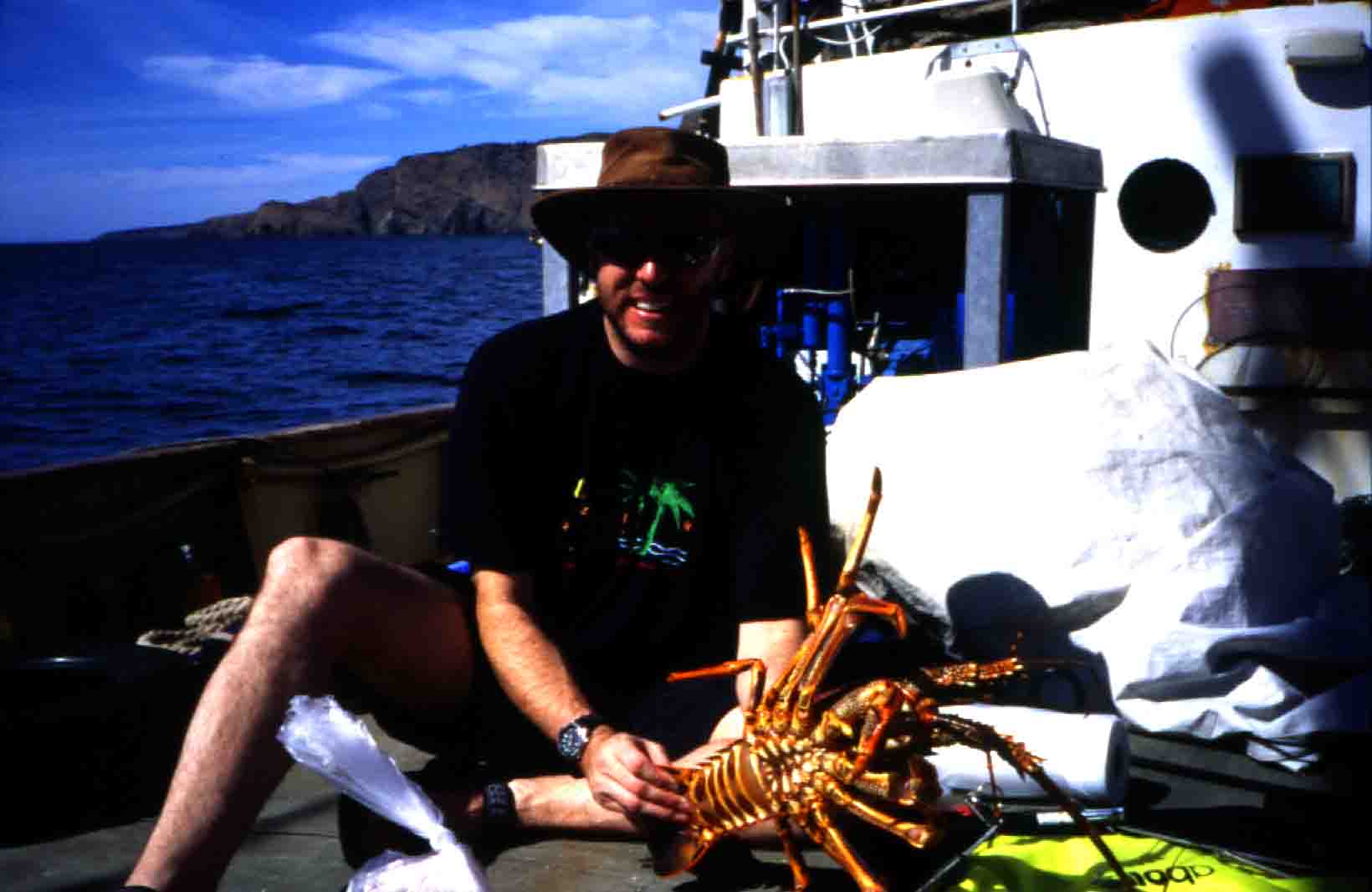
Southern Rock Lobster (and Craig)
photographed by
Chris Hall
Lunch over it was time for the first group to kit up so we had some time on our hands. The weather was just perfect. A few sprawled out on the deck to catch a few gammas, another couple threw in some fishing lines to catch some fish, a few more lolled around listening to the footy on the radio and I just relaxed in a shady spot enjoying the peace and tranquillity. As I was reflecting on what a great trip this had been I was awaken from my reverie by the clamour of divers getting their gear ready. I had to rush to get kitted up but I wasn’t going to miss out on the last dive of the trip.
Once in the boat our group agreed to dive the same spot as before because we had all seen different things. We weren’t disappointed.
I went off in search of a small cavern that I had been told of that was covered in gorgonians and when I found it I was awe struck. The cavern was about 2-3 metres wide and about 3-4 metres deep, completely covered with yellow, red and white gorgonians. It was quite breathtaking. In this small and compacted area there were dozens of these gorgonians hanging off the ceiling and walls. I spent some time admiring the spectacle then took a couple of photos. Unfortunately they didn't turn out too good but the memory still lingers on. The rest of the dive was pretty uneventful but still another brilliant dive. As I descended and looked up I could see a pattern of gold and silver sunrays piercing the deep blue of the sea. It was just magic and a fitting climax to nine great dives.
On the way back to the ship we circled around the Falie taking in the spectacle of a beautiful ship at anchor in an idyllic setting as well as a couple of photos to remind us of a great and successful diving trip.
Back on board it was time to clean and pack up. As there weren’t any mores dives the drinks began to flow freely. We packed and stowed away our gear as the crew lifted the boats back on board and made ready for our trip back to port. While the crew scurried around raising the anchor and making way the divers sat around chatting and toasting cheer to four brilliant days of diving. The galley crew appeased our appetites with more delights from the galley as we sailed off into the sunset.
As the sun sank slowly in the west we turned east for home and watched as the sky darkened and the stars began to fill the night sky.
The dinner bell rang for the final time as we left the deck and the stars behind to sup again on another superb three-course meal. It amazed me how the chef and his galley hand could produce such excellent meals in such a tiny space.
After dinner most of us dispersed either to our cabins or to the deck but a few lingered on to sup that great South Aussie wine. Up on deck you could just make out the sole of Yorke Peninsula and the north coast of Kangaroo Island as the Easter moon started to rise in the ebony sky. I spent some time admiring the spectacle and chatting to the helmsman.
At about nine o’clock there was a call to supper of fresh crayfish barbequed and abalone. What a treat! All freshly caught that afternoon. There was only about half a dozen or so to partake of this feast so there was plenty to go around. With our bellies full and the quest for diving sated most of us headed to our cabins, exhausted but delighted with the diving holiday.
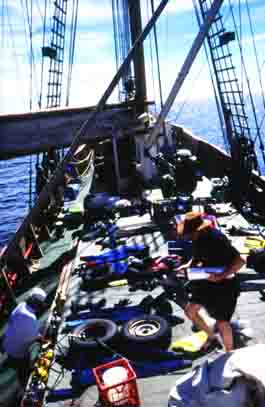
Gear drying on the Falie
Clunk, clunk, clunk went the engine as my head hit the pillow and that was the last sound I heard ‘til the following morning. Awakening to the sounds of people busying themselves I realised we must be nearing port. I dressed and packed my bags then headed up on deck. We had just entered the Port River and heading for the wharf.
About half an hour later we drew alongside No.10 Berth with the skipper at the helm. As he manoeuvred the ship into place activity on the deck was frantic with people going every direction. Some of the crew was tying up the ship, while others assisted with the unloading as the divers were sorted out their own gear, both personal and diving. About twenty minutes after docking things were starting to take shape. The wharf was a mass of dive gear, stores and personal belongings as people started loading up their cars. Once all the loading and packing had been completed it was time to say our good byes and thank the crew for their magnificent assistance over the last four and a half days, which greatly contributed to a brilliant, diving trip.
I had managed to organise a lift home and after several stops dropping divers off it was home at last.
One last surprise in store, Veronica who had given me the lift home produced a crayfish out of her Esky, saying that it was an extra one and would I like it. Yes please! A perfect end to my diving trip on the Falie.
Part 6
By Steve Reynolds
On Monday 8th April there was a re-enactment of the encounter out to sea in Encounter Bay. A flotilla of six ships re-enacted the encounter six nautical miles SSE of the Murray Mouth. The Seafarer II from Kangaroo Island joined up with the four tall ships and the Vendemiaire, all gathering at the exact spot where Flinders and Baudin met 200 years earlier (35 deg., 40 mins south and 138 deg.58 mins. east).
A time capsule was dropped from the One and All during a ceremony involving all of the ships. The time capsule was encased in a pyramid-shaped block of cement and it included a plaque commemorating the 200th anniversary of Flinders and Baudin’s meeting. The capsule is to be retrieved in another 100 years time.
On Friday 12th April Anthony Brown gave a talk titled "Ill-Starred Captains" at John Ford’s exhibition "Chart the Art of Discovery" in Port Adelaide. I attended this talk and was able to sit and chat with Ian O’Donnell. John Ford also gave a couple of talks. We had supper afterwards and I was able to chat with many interesting people including John Ford, Anne Levy and Anthony Brown.
(This was the second time that I had attended a talk by Anthony Brown since Philip Hall had invited me along to a talk that Anthony gave at the AGM of the Coromandel Valley Residents Association late in 2000.)
The final location for the tall ships was Robe. The Enterprize and One and All were both there on Saturday 13th April. They both sailed around Guichen Bay in front of about 5,000 people. Robe was hosting the closing events of the Encounter 2002 program. They held events such as "Encounter the Senses" and the "Three Worlds Food and Wine Feast". There was a grand parade on the foreshore and the Governor, Mrs Marjorie Jackson-Nelson, launched a contemporary sculpture at the site of the original obelisk there. There was the obligatory petanque competition and sailing regatta and the local fishing fleet did a sail past.
No sooner had the "Matthew Flinders: The Ultimate Voyage" exhibition finished at the SA Maritime Museum (23rd June) then it was replaced by a Nicolas Baudin exhibition which ran from 5th July until 14th October. It was titled "Baudin: Voyage of Discovery to the Southern Lands" and was produced by the WA Museum. I was able to see this exhibition on 10th August.
Kevin Jones, the Director of the Maritime Museum, advised me that the touring exhibition "The Encounter: Flinders and Baudin" which we had provided specimens for will become a permanent exhibition at the museum in February 2003.
Kevin also told me that the touring exhibition had toured nine regional ports. It opened in Ceduna in February and moved through Port Lincoln, Whyalla, Port Augusta, Port Pirie, Port Victoria, Kingscote, Victor Harbor and Robe. He says that it was very successful and reached over 8,000 people in regional SA.
Anthony Brown was the guest speaker at our 17th July General Meeting. His topic was the expeditions of both Flinders and Baudin and it included reference to the collecting of marine specimens that occurred. This was the third time in months that I had attended a talk by Anthony Brown.
In October 2002 ABC TV showed a two-part documentary series about the voyages of both Flinders and Baudin. The series, called "The Navigators", was filmed by a Klaus Toft. I video recorded it all and managed to squeeze both parts onto my Postcards "Encounter" tape.
From 2nd to the 24th November 2002 exhibitions were held at McLaren Vale wineries in conjunction with the 2002 Fleurieu Art Prize. A ‘Rim Exhibition’ was held at the Hugh Hamilton Winery in McMurtrie Road at McLaren Vale. It was another John Ford exhibition about the ‘Encounter’. This one was titled "Chart the Art of Discovery on the Fleurieu".
The Advertiser
During the Encounter 2002 program, The Advertiser regularly reported events and many letters to the Editor of The Advertiser concerned those events and the history involved. The Advertiser also ran a four-part series about Encounter 2002 as part of its Newspapers In Education specials. The four-part series was sub-titled "Discovery of the Unknown Coast". Part 1 was titled "The Explorers", Part 2 "The Encounter, Part 3 "Science of the Voyages", Part 4 "Life on board". Each part consisted of four pages, each having a centre-spread.
Disappointments
There were a handful of disappointments regarding Encounter 2002. One of these was the lack of recognition by the Federal Government who didn’t send the Australian Navy hydrographic research ship HMAS Leeuwin to take part in the program as planned. Anthony Brown was apparently "incensed" that the Royal Australian Navy did not provide a warship to "meet" the French frigate Vendemiaire (The Advertiser 5/4/02).
Then there was the proposed search for the Casuarina’s lost anchor. Little progress has been made regarding this proposal to date. Terry Arnott, Principal Maritime Archaeologist with the Department of Environment and Heritage (Heritage SA), advised me recently that this project is on-going, but making slow progress.
Another disappointment, for me, was that the Official Program for Encounter 2002 incorrectly showed a picture of Alan Bond’s replica Endeavour instead of the Young Endeavour which had been built in England.
An SA tourism lift-out in The Advertiser about Kangaroo Island suggested that the island has a French side and an English side because when Flinders and Baudin met during their encounter "both sides agreed that Flinders would map the northern coast while Baudin would chart the west and south". Nothing could be further from the truth since Flinders had already mapped the north coast and it was the following year when Baudin returned to the area and headed straight for the south coast knowing that Flinders had already been on the north coast. Baudin then proceeded around the west coast and spent a great deal of time on the north coast.
Sue Barker, the President of the Royal Geographical Society of SA, said in her Prologue (Introduction) to the 2000 issue (No.99) of the South Australian Geographical Journal "that 2102 should present the (Royal) Society with an opportunity for reviewing the advancement of geographical science since . . . . Australia first appeared on the world map". The 2000 issue of their Journal was an Encounter special issue.
I can’t help but feel that they should have done just that (reviewed the advancement of geographical science) this year (2002). *There is still an opportunity to do that now since 2003 is the 200th anniversary of Baudin’s return to SA waters to complete his charting of our coastline, particularly that of Kangaroo Island, and continue the search for and collection of endemic flora and fauna.
As I said in my previous article, Baudin’s naturalist Francois Peron wrote about the voyage of discovery to Australia. Chapter XXIV of his second volume published in 1816 ("Voyage de Decouvertes aux Terres Australes, Vol.II") was reproduced in "Natural History of Kangaroo Island" by the Royal Society of South Australia (Chapter 15 – Historical Perspective: Kangaroo Island - 1803).
(* Although not an Encounter 2002 event, former French Prime Minister Michel Rocard revisited SA in March 2003 to celebrate Baudin’s circumnavigation of Kangaroo Island. He also unveiled a bust of Baudin at the Art Gallery of SA and dined with Premier Rann.)
Applying Pain Theory In Fish Spine Envenomation
By David Muirhead
Part 3
The references listed will be given in the final part of this article.
The Estuary Catf
ish (Cnidoglanis macrocephalus) is the only marine member of the Plotosidae family known to occur in southern Australia, but most northern Australian catfish-spine injuries are also due to this family.16The ‘Poisindex Managements’17 first aid treatment guidelines for catfish state:
"HOT WATER - The injured pan should then be submerged in hot water at as high a temperature as the patient can tolerate without injury (less than 113 degrees F or 45 degrees C), for 30 to 90 minutes or more."
However, none of the three references provided contain proof of heat-lability of catfish venom. Indeed, Sutherland and Tibballs18 in their chapter titled Venomous fish other than stonefish, state:
"Little is known about the nature of the venoms, which are associated with the spines of the many stinging fish found in Australian waters...Most of these fish venoms are presumably unstable in heat, and the aim of such treatment is to inactivate the venom present superficially and under the skin."
The text Venomous and Poisonous Marine Animals, a Medical and Biological Handbook,16 while covering in considerable detail many aspects of catfish envenomation, contains only one direct comment on the possible heat-labile nature of fish venoms:
"Fish venoms are predominantly unstable large proteins (Halstead 1988). As such molecules are dissociated with changes in pH and temperature, hot-water immersion might cause denaturation of the venom in the tissues. However, the return of pain on extraction of the part from hot water casts some doubt on this rationale. The analgesic efficacy of hot-water immersion for venomous fish injuries cannot be disputed and should always be adopted by first-aiders as a first measure for pain relief in venomous fish stings."
In summary, certain facts emerge concerning catfish envenomation. Most (probably all) catfish of the Plotosidae family contain venom apparatus and are a common cause worldwide of fish spine envenomations in humans. No scientific study has ever demonstrated heat-lability of catfish venom (to the best of my knowledge).
Might not the Gate Control and DNIC theories of pain explain the underlying mechanism for fish spine envenomation analgesia by hot water immersion?
Kakigi and Watanabe have shown that interference stimulations using vibration, active and passive movements of the hand or foot, noxious warming by hot water (46°C) and noxious cooling by ice water (0°C) all caused significant reduction in pain perception in normal human volunteers who were experiencing painful stimulation of either ipsilateral or contralateral hand or foot via CO laser.5 Specifically, they noted markedly reduced pain amplitude using noxious warming and cooling stimulation applied to the peripheral skin close to and remote from the site where laser stimulation was applied.
They deduced that, since the hot and cold stimuli mainly ascend through the small fibres, this pain relief could be better accounted for by DNIC theory than Gate Control theory, and they refer to clinical studies indicating that the site responsible for DNIC is the brainstem. Whilst an account of DNIC theory is beyond the scope of this paper, its application in the above study is clearly relevant to the phenomenon of hot water analgesia in fish spine envenomation, particularly as the study used water at 46°C as the noxious stimulus. Further, standardised pain scores three to six minutes after taking the hand from the hot water (after-effect) did not show any significant change from the control session, consistent with my personal experience of rapid return of pain following arm removal from hot water.
Anniversaries
This newsletter (June 2003) is our 300th issue. Our meeting on 18th June 2003 is our 27th anniversary meeting. The July issue of the newsletter (No.301) will be the 27th anniversary issue. Many thanks to all involved for ensuring that our Society has continued successfully and our newsletter has reached the 300th issue milestone. Our next main anniversary will be our 30th anniversary in June 2006.
Steve Reynolds
Anniversary Trophy
At our June 2002 meeting our President, Philip Hall, presented the Anniversary Trophy (for the member that he considered deserving of recognition for the work that they have done over the year) to his wife Margaret for all of her behind the scenes efforts on our behalf. Congratulations Margaret, you deserved it. The Anniversary Trophy will be presented to a worthy recipient each June, which represents another anniversary for the Society. This year Margaret gets to present the trophy to a worthy member.
I wish to start an honours list for the trophy now, as follows :-
YEAR ANNIVERSARY RECIPIENT
2001 25th Philip Hall
2002 26th Margaret Hall
2003 27th ?
Steve Reynolds
The Editor
Our President, Philip Hall, has also been our Editor for some 6 years. He officially became our Editor at our AGM in May 1997. I say ‘officially’ because he had already been our ‘unofficial’ editor for a while by taking some of the load off of my shoulders prior to that. Philip’s first official newsletter was the June 1997 issue (No.234). By the time that you read this Philip will have edited some 66 newsletter issues (plus 4 annual Journals). Congratulations Philip, it’s a wonderful milestone. It would take the best part of another four years to reach the magical century. I hope that Philip can keep it going for that long.
Our Editor has now had the honour of editing this our 300th newsletter, another great milestone for our Society.
Now every newsletter needs to be printed and everything that I’ve said about Philip editing it can be repeated about Phill McPeake doing the printing, so well done Phill. Next time that you see either of the two Phil(l)s give them a pat on the back.
Steve Reynolds
Contacts Sought
I am interested to find a contact with anybody interested in Argonauta argo. Can you please help me? Below is some background information about the early study of this cephalopod.
Jeannette Power was born Jeanne de Villepreux in France1794. She later became married to a rich English merchant called James Power. In 1832 she made a close study of the Argonauta argo. As part of her work, she created and used the first known aquariums. Below is a document dated 1858, published in "Mollusca" by the famous Prof. Richard Owen about it.
"Introduction to MOLLUSCA (page 328) by Prof. Richard Owen (1858)
The knowledge of the varying forms of the living Mollusks, of their habits and powers, has been increased, and is likely to be materially advanced, by the rapidly extending practice of preserving them in confined spaces of sea or fresh water. Poli, Montagu, and before them probably other lovers of nature, resident near the sea, availed themselves of large vessels to keep alive, in frequently renewed sea-water, the marine animals in the study of which they were interested. But to Madame Jeannette Power (née de Villepreux), according to the testimony of Professor Carmelo Maravigna, in the Journal du Cabinet Littéraire de l’Academia Gioenia, of Catania, for December 1834, ought to be attributed, if to any one individual, the invention and systematic application of the receptacles now called Aquaria, to the study of marine, and principally of molluscous animals.
Madame Power invented three kinds: one of glass, for preserving and studying living Mollusca in a room; another, also of glass, for small Mollusks, protected by an external cage of bars, in which they could be kept submerged in the sea, and withdrawn at will for inspection; and a third kind of cage for larger Mollusks, which could be sunk and anchored at a given depth in the sea, and raised, when required, for the purpose of observation and experiment. With these different kinds of molluscous menageries, of which the first answers to our present improved and enlarged aquaria, Madame Power carried on her observations and experiments from the year 1832 to 1842 at Messina in Sicily.
She determined the question of the true relation of the Argonauta, or Paper Nautilus, to the delicate boat-like shell which it inhabits. She first showed that the so-called "sails" were normally applied over the exterior of the shell, and proved experimentally that they were the organs which formed and repaired the shell. She proved that the Bulla lignaria preyed upon, and by its strong gizzard ground down and digested, the Dentalium entale. She described the curious manoeuvers by which the Astropecten aurantiacus seized and conveyed to its mouth and stomach small Naticae. And many other interesting facts were brought to light by this persevering and ingenious observer, through the application of the "Gabioline alla Power", as her aquaria were termed by the Gioenia Academy, some years before the practice of so studying aquatic animals was introduced and diffused in this country."
For years there was a great argument between Owen, the French naturalist Ducrotay de Blainville and others about the origin of the beautiful shell. Blainville wanted the Argonauta to be a squatter in the shell and Owen had the opposite opinion. Jeannette Power solved the problem years later when breaking shells. She proved that the cephalopod was able to repair it. In 1856 she published (in French): "Le poulpe de l’Argonauta argo"*, and other marine studies in 1860. Forgotten for more than 120 years, she and her works are now coming back to light. I now have a lot of documentation about it. In the USA, following Owen's testimony, she has become the mother of aquariophily and marine biology.
You will find details about her on many web sites by using the keywords "Villepreux-Power". I found a study about the Argonauta on your web site, so I think that some of you could be interested by the cephalopod.
I am interested to find a contact with anybody interested in such a history and particularly with the Argonauta argo. Can you please help me?
Claude Arnal
Claude sent us a four-page bibliography of Jeannette Power (née Jeanne Villepreux) with the above request. He later sent us two interesting documents (in English) from his archives. These were: -
The bibliography and two documents are now available from our Society’s library for loan to our members.
Steve Reynolds
Library Officer (2003-4)
William (Bill) B. Henry
Some three years ago an American woodcarver contacted me asking for details of the Leafy Seadragon as he wished to carve a model. The result is spectacular and shown in the following pictures.
Philip Hall
Notes On The Leafy Seadragon Woodcarving
The pattern was drawn up from many different picture sources.
The choice of woods were:
Bass (English Lime) wood is an easily carved hard wood and was used for the head and body.
Maple wood was used because of its strength for the tail section.
The plumage was tried in several woods but all lacked the strength I needed. I settled on a composite material which would give the strength needed and be still be carveable.
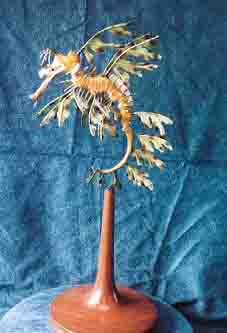
The mounting of the Dragon to the base is a piece of brass rod soldered into a piece of square tube, with a companion square tube in the base as a socket. The plumage took the most time to figure out and produce.
The base is Mahogany and turned on a lathe. I made the shape to represent a hold fast of kelp.
I have shown this piece at several woodcarving competitions and it never fails to take top honors.
The woodcarving has been selected to be on display at the New Jersey State Aquarium along side their tank of "live" Leafy Seadragons.
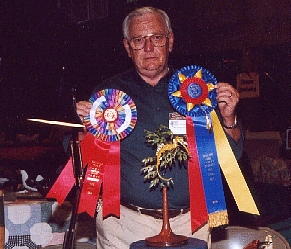
Future plans are to do several more woodcarving of Leafy Seadragons. One of which will be a mated pair with the male carrying the eggs. Here again my knowledge and information of "pregnant" male seadragons is sketchy. Any info any one would like to share would be appreciated.
William (Bill) B. Henry
2264 Rebecca Drive
Hatfield, Pa. 19440 USA
Ph: (215) 822-2875
E-mail Address:
wbhenry1@comcast.net